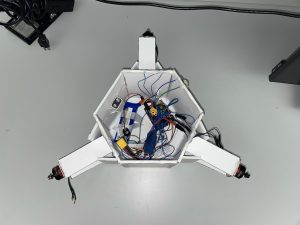Last week we focused on making an MVP housing out of foam core and populating it with a few components needed to do thrust testing during a drop. We had our first test with it last week, which failed due to spinning, and hope test again next week. We also performed tests that showed that our directional antennas were not a viable perception method because of their lack or resolution and inability to tell direction with enough accuracy. This involved around in a fixed radii and seeing if the antenna could discern if the beacon was in the “center” of it’s beam path.
This week, I focused on improving the state of.our MVP, with new code for our Arduino test platform, an ultrasound sensor to detect when to stop when our device is above the ground, and a new protoboard where many of our connections were soldered in order to make sure everything is secure now in the event of flipping or spinning. This new board houses I/O in the form of buttons to start and reset the motor spinning up process, in addition to the ultrasonic sensor. Additionally, I’m starting to model our new design for the housing that is based on the hexagonal shape that we prototyped out of foam core. This will hopefully be lighter than our original 3d printed design, and easier to manufacture (time-wise) as well. Some key issues we found with our original design was the print time and the estimated weight in PLA plastic that it would take on. The next steps are to use this updated test platform for another powered drop test, and hopefully for a perception test with our new camera system soon. This camera system will detect a black and white marker placed on the ground and use that to do it’s direction-finding. This way the control method doesn’t have to change much, just the perception method turning an image into a direction to travel in instead of an antenna array. This will hopefully allow us to do more fine-grained control as well, should we need it. Currently, we are on schedule and the new and updated housing will be continued over the next week in order to have our final build housed in a weather-proof container. The indicator LEDs and I/O buttons should also make setting up/ using our system significantly easier.



